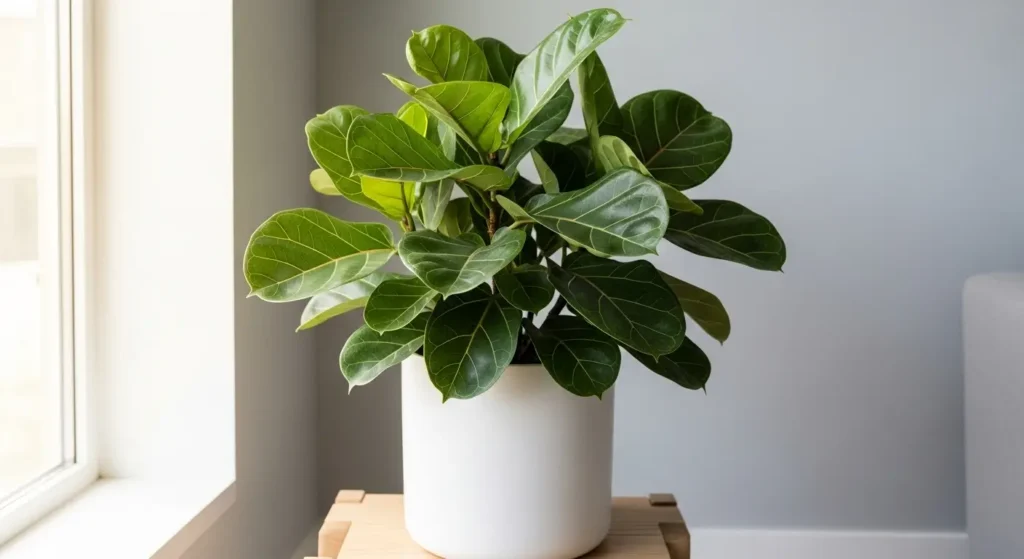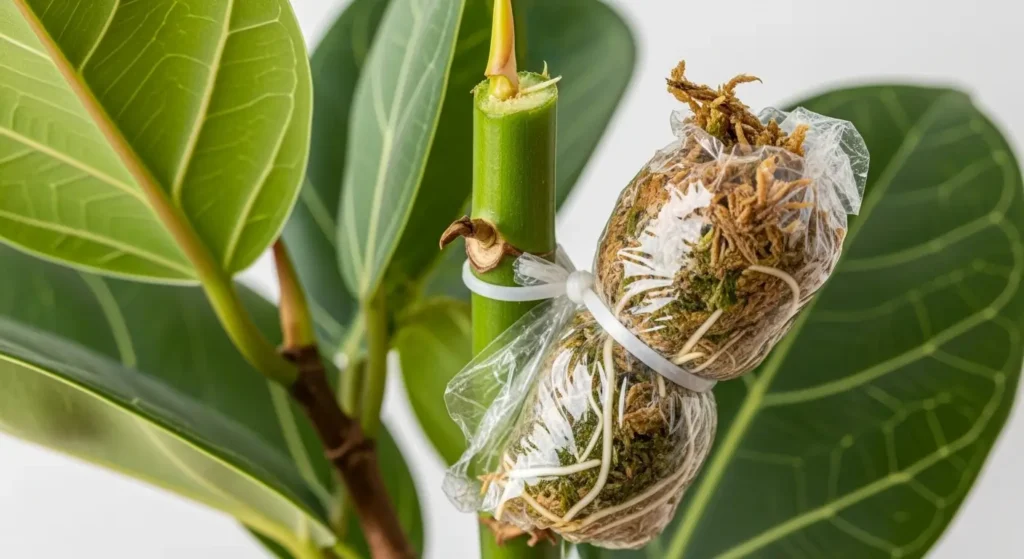
In This Article
Ficus audrey (Ficus benghalensis) is rapidly becoming a houseplant favorite, and it’s easy to see why. This stunning tree features large, velvety leaves with distinctive pale veining that adds instant visual appeal. Native to India and Pakistan, it’s celebrated as a more forgiving alternative to the temperamental fiddle leaf fig. With moderate care requirements and excellent adaptability to indoor conditions, the ficus audrey offers elegant height and texture for both novice and experienced plant enthusiasts.
Plant Care Card
| Care Aspect | Details |
|---|---|
| Common Name | Ficus Audrey, Audrey Fig |
| Botanical Name | Ficus benghalensis ‘Audrey’ |
| Family | Moraceae |
| Plant Type | Evergreen tropical tree |
| Mature Size | 5-10 feet tall indoors, 3-5 feet spread |
| Sun Exposure | Bright indirect light |
| Soil Type | Well-draining, moisture-retentive |
| Soil pH | 6.0-7.5 (slightly acidic to neutral) |
| Hardiness Zones | 10-12 (USDA) |
| Native Area | India, Pakistan, Southeast Asia |
| Toxicity | Toxic to pets and humans |
Ficus Audrey Care
ficus audrey is a relatively low-maintenance plant that adapts well to indoor conditions when given proper attention. Here’s everything you need to know about light, water, soil, and more to keep it thriving. With just a little consistency, you’ll have a healthy, happy tree that becomes a stunning focal point in your home.
Light
This plant thrives in bright, indirect light for at least six hours daily. Place it near an east-facing window for gentle morning sun, or a few feet back from a south or west-facing window. Too much direct sunlight will scorch those beautiful leaves, creating brown, crispy patches you definitely don’t want.
On the other hand, insufficient light causes leggy growth and slower development. You’ll notice the stems stretching toward the light source if it’s not getting enough. Additionally, rotate your plant every few weeks so all sides receive equal light exposure.
Soil
ficus audrey needs a well-draining potting mix that retains some moisture without becoming waterlogged. According to University of Florida IFAS Extension, proper soil drainage is critical for preventing root diseases in tropical houseplants. A quality soil-based potting mix works wonderfully, or you can create your own blend using equal parts peat moss, perlite, and regular potting soil.
The key is making sure excess water drains freely while keeping the roots happy. Adding a bit of charcoal to your mix improves aeration and prevents that stale soil smell.
Water
Water your plant when the top 2-3 inches of soil feel dry to the touch. Stick your finger in the soil to check moisture levels before watering. When you do water, saturate the soil thoroughly until water drains from the bottom holes, then empty the saucer.
Overwatering is the biggest mistake people make with this plant. Yellow leaves and mushy stems signal you’re watering too much. In contrast, underwatering causes leaves to droop and eventually drop off the plant. During spring and summer, you’ll water more frequently as the plant actively grows. However, reduce watering in fall and winter when growth naturally slows down.
Temperature and Humidity
Keep temperatures between 65-80°F for optimal growth, with nighttime temps not dropping below 60°F. This tropical plant hates cold drafts, sudden temperature swings, and proximity to heating or cooling vents. Place it away from drafty windows during winter months.
Humidity levels between 50-80% keep those leaves looking lush and healthy. Similar to elephant ears plants, these tropical beauties thrive in humid environments. If your home is dry, try misting the leaves weekly or using a humidifier nearby.
Fertilizer
Feed your ficus audrey with a balanced liquid fertilizer diluted to half strength every 2-4 weeks during spring and summer. Stop or significantly reduce feeding during fall and winter when the plant enters its slower growth phase.
Propagating Ficus Audrey
The best time to propagate is during spring and summer when the plant is actively growing.
Propagating by Stem Cuttings
This is the most popular and reliable method for creating new plants from your ficus audrey.
Materials needed:
- Clean, sharp pruning shears or knife
- Small pot with drainage holes
- Well-draining potting mix
- Rooting hormone (optional)
- Clear plastic bag
Step 1: Select a healthy stem that’s at least 6-8 inches long with several leaves attached. Make your cut just below a leaf node using sterilized tools to prevent introducing disease.
Step 2: Remove the lower leaves from the bottom half of the cutting, leaving 2-3 leaves at the top. Dip the cut end in rooting hormone if you have it available, though it’s not absolutely necessary for success.
Step 3: Plant the cutting in moist potting mix, burying about 2-3 inches of the stem. Water lightly and cover with a plastic bag to maintain humidity around the cutting.
Step 4: Place the pot in bright, indirect light and keep the soil consistently moist but not soggy. According to North Carolina State University Extension, most ficus species root successfully within 4-6 weeks when given proper conditions.
Propagating by Air Layering

This method works well for older plants with thicker stems and gives you a larger plant more quickly.
Step 1: Choose a healthy stem and make a small upward cut about one-third through the stem, approximately 12 inches from the tip. Insert a toothpick to keep the wound open.
Step 2: Dust the wound with rooting hormone, then wrap the area with moist sphagnum moss. Cover the moss completely with plastic wrap, securing both ends with twist ties.
Step 3: Check weekly to make sure the moss stays moist, adding water with a syringe if needed. Once roots are visible through the moss (usually 6-8 weeks), cut below the root ball and pot separately.
Potting and Repotting Ficus Audrey
Repot your ficus audrey when you notice roots growing out of drainage holes or circling the inside of the pot. Growth may slow down, or water might run straight through without being absorbed. Most plants need repotting every 1-2 years, typically in spring.
Choose a pot that’s 1-2 inches larger in diameter than the current one. Too much extra space holds excess water, increasing root rot risk. Gently remove the plant, loosen compacted roots, and place it in fresh soil at the same depth. Water thoroughly after repotting and keep it in slightly lower light for a week while it adjusts.
Common Pests and Diseases
Like most houseplants, ficus audrey can occasionally attract pests, especially when stressed or growing in dry conditions.
Spider Mites

Look for fine webbing on leaves and tiny moving dots on the undersides. Leaves may develop yellow stippling or a dusty appearance. Treat by wiping leaves with a damp cloth and spraying with insecticidal soap weekly until gone.
Mealybugs
These appear as white, cottony masses in leaf joints and along stems. They suck sap from the plant, causing yellowing and stunted growth. Remove with rubbing alcohol on a cotton swab, or spray with neem oil every 5-7 days.
Scale Insects
Small, brown, shell-like bumps attach themselves to stems and leaf undersides. They’re immobile but damage the plant by feeding on sap. Scrape them off with your fingernail, then treat with horticultural oil.
Aphids
These small insects cluster on new growth and leaf undersides, excreting sticky honeydew that attracts ants. Rinse them off with water or apply insecticidal soap to affected areas.
Common Problems with Ficus Audrey
Here’s how to troubleshoot common issues:
Yellow Leaves
Yellow leaves are usually your first sign something’s off with watering. Overwatering is the most common culprit, causing roots to sit in soggy soil and eventually rot. Check that your pot has adequate drainage and let the soil dry out more between waterings.
Nutrient deficiency can also cause yellowing, especially in older, lower leaves. Feed your plant regularly during the growing season to prevent this. Just like with white bird of paradise plants, proper fertilization prevents most nutrient-related yellowing. Finally, some yellowing of the oldest bottom leaves is totally natural as the plant matures.
Brown Leaves
Brown leaf tips or edges typically indicate low humidity levels in your home. Increase moisture around your plant with a humidifier or pebble tray. Poor water quality with high mineral content can also cause brown tips, so consider using filtered or distilled water.
Underwatering leads to brown, crispy leaves that eventually drop off. Make sure you’re watering deeply when the top few inches of soil dry out. Additionally, check that your plant isn’t sitting near heat sources or air vents that create dry conditions.
Drooping or Wilting Leaves
Drooping leaves usually signal watering issues, either too much or too little. Check the soil moisture level immediately to determine which problem you’re facing. If the soil is bone dry, give your plant a thorough soaking and it should perk up within a day.
If the soil is soggy, you’ve been overwatering and the roots may be damaged. Let the soil dry out significantly and reduce watering frequency going forward. Prevention is key with moisture-sensitive plants.
Leggy Growth
Insufficient light causes your ficus audrey to stretch toward the light source, creating long, spindly stems with sparse foliage. Move it to a brighter location immediately for more compact growth. You can also prune back leggy stems to encourage bushier development. According to Iowa State University Extension, adequate light exposure is essential for maintaining compact, healthy growth in tropical houseplants. Similar issues affect philodendron brasil and other tropical indoor plants when lighting isn’t optimal.
FAQ
Is a Ficus Audrey a good indoor plant?
Absolutely! ficus audrey makes an excellent indoor plant for most homes. It’s significantly easier to care for than the fiddle leaf fig, tolerating occasional care mistakes. The plant adds instant style while purifying indoor air naturally.
Is the Ficus Audrey easy or hard?
This plant falls into the easy-to-moderate care category. It’s forgiving of occasional mistakes and bounces back quickly. Once you establish a routine with watering and light, it’s quite low-maintenance.
Is Ficus Audrey safe for pets?
No, ficus audrey is toxic to cats, dogs, and humans if ingested. The milky sap causes mouth irritation, drooling, and vomiting. Keep it out of reach of pets and children.
How to make Ficus Audrey bushy indoors?
Prune back the top growth during spring to encourage side branches. Provide adequate bright light and rotate regularly for even growth. Consistent fertilizing also promotes fuller, denser foliage.

1 thought on “How to Grow and Care for Ficus Audrey: Complete Guide”
Comments are closed.